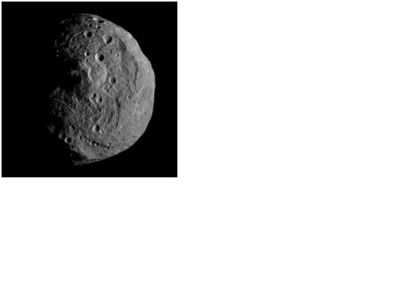16 October 2011
This picture is a computer-generated image, showing a high mountain (left of center), in the southern polar region of asteroid Vesta, the most massive asteroid. The image was based on data acquired by NASA’s Dawn spacecraft, which is currently in orbit around Vesta. It also shows a magnificent large scarp, a cliff with a steep slope, seen on its right.
Credit: NASA/JPL-Caltech/UCLA/MPS/DLR/IDA/PSI
NASA recently published images relayed by the Dawn spacecraft, currently orbiting the large asteroid Vesta, revealing the discovery of a huge mountain in Vesta’s south polar region. Vesta (about 530 km across), is the most massive asteroid. Its lofty mountain, whose peak towers about 22 km higher than the surrounding terrain, is nearly three times as high as Mt. Everest, and is one of the tallest mountains in the Solar System.
The asteroids are small rocky objects, mainly orbiting the Sun in a zone between the orbits of Mars and Jupiter, termed the asteroid belt. They are believed to be primitive objects, leftovers from the formation of the Solar System. By studying the chemical composition of the asteroids, scientists hope to achieve a better understanding of the origin and evolution of the Solar System.

A Dawn spacecraft image of asteroid Vesta, one of the largest asteroids. Dawn entered orbit around Vesta on 16 July 2011, after flying in interplanetary space for nearly four years. Dawn will explore Vesta from orbit, for a year.
Credit: NASA/JPL-Caltech/UCLA/MPS/DLR/IDA

A Hubble Space Telescope image of the dwarf planet Ceres, the next target in Dawn’s voyage.
Credit: NASA, ESA, J. Parker (Southwest Research Institute), P. Thomas (Cornell University), and L. McFadden (University of Maryland, College Park)
Dawn entered orbit around Vesta in July 2011. It will study Vesta for a year, then depart, in July 2012, for dwarf planet Ceres (about 950 km across), the largest and most massive object in the asteroid belt, to reach it in 2015.
Vesta is one of the largest asteroids. It orbits the Sun, in the asteroid belt, every 3.63 years, at an average distance of approximately 353 million km. Ceres, also believed to be a primitive body, orbits the Sun every 4.6 years, at an average distance of approximately 410 million km. The names Vesta and Ceres come from Roman mythology.
The prime object of Dawn’s mission is to characterize and contrast Vesta and Ceres, for new insights into the dawn of the Solar System.
Further Reading
The Dawn Mission Homepage
http://www.nasa.gov/dawn
References
NASA
www.nasa.gov/
Wikipedia
Aymen Mohamed Ibrahem
Senior Astronomy Specialist